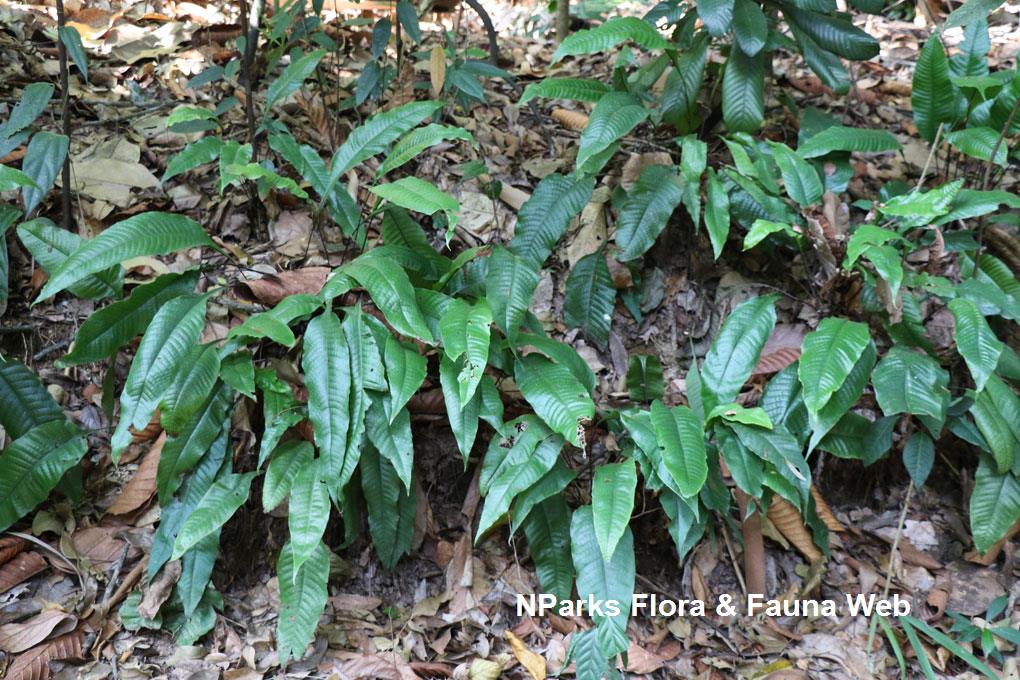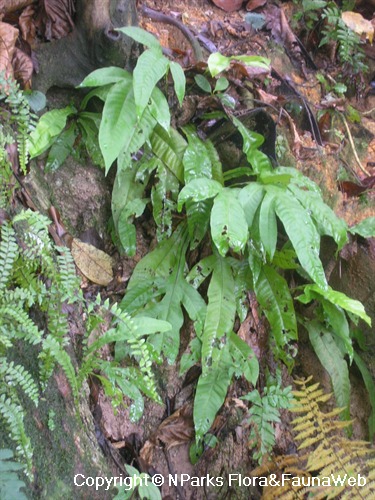.jpg)
Back
Tectaria incisa Cav.
| Family Name: | Tectariaceae |
| Common Name: | Incised Halberd Fern |
Tectaria incisa or Incised Halberd Fern is large terrestrial fern with creeping rhizomes and fronds growing up to 1.5 m tall. It has bipinnatifid fronds that are pale green, holding up to 7 pairs of leaflets with its lowest pair producing 1 -2 enlarged lobes. Sori are large, produced on 2 rows on either side of the veinlets protected by a round to kidney-shaped indusia.
Name
Classifications and Characteristics
| Plant Division | Ferns & Lycophytes (Non-Seed Vascular Plants) (Fern) |
|---|---|
| Plant Growth Form | Herbaceous Plant |
Biogeography
| Native Distribution | Tropical to Subtropical America |
|---|---|
| Native Habitat | Terrestrial (Disturbed Area / Open Ground, Primary Rainforest, Secondary Rainforest, Riverine, Inland Cliff) |
| Preferred Climate Zone | Tropical, Sub-Tropical / Monsoonal |
| Local Conservation Status | Non-native (Spontaneous (Naturalised)) |
Description and Ethnobotany
| Growth Form | It is a large terrestrial fern with erect, short-creeping rhizomes and fronds growing up to 150 cm in length. |
|---|---|
| Foliage | Fronds are bipinnatifid, 70 - 150 cm long, held on a straw to brownish coloured stalk. The blade is pale green, not very leathery or shiny, holding up to 7 pairs of leaflets with its lowest pair producing 1, sometimes 2 enlarged lobes. The leaflets never divides into smaller leaflets hence bipinnate foliage is not observed in this species. |
| Reproductive Parts - non-flowering plant | Sori produced in 2 rows on either side of the veinlets protected a layer known as indusia that is round to kidney-shaped. <1> |
| Others - Plant Morphology | Rhizomes are erect, short. The tips of the rhizomes and base of the stalk are covered with ovate scales. |
| Habitat | Occurs in primary forest, cloud forest, along hillsides, ravines and roadside, often found among rocks, on wet shade cliffs 100 - 2100 m in altitude. <2> In Singapore, it is a garden plant naturalised in many secondary forests and in the margins of primary forest. Prefers moist sites such as streambanks and drainage ditches. |
| Similar | Tectaria incisa and Tectaria barberi are similar in appearance. The key differences are found in the sori. The sori of Tectaria barbei are small, round to oblong, irregularly scattered on the underside. They also lack an indusia which is present in Tectaria incisa. Tectaria incisa have larger sori arranged along the sides of the veinlets protected by a round to kidney-shaped indusia. |
| Cultivation | It can be propagated by spores. |
Plant Care and Propagation
| Light Preference | Semi-Shade, Full Shade |
|---|---|
| Water Preference | Moderate Water, Occasional Misting |
| Plant Growth Rate | Moderate |
| Rootzone Tolerance | Fertile Loamy Soils, Moist Soils, Well-Drained Soils |
| Propagation Method | Spore |
Foliar
| Foliage Retention | Evergreen |
|---|---|
| Mature Foliage Colour(s) | Green - Light Green |
| Foliar Type | Compound |
| Foliar Shape(s) | Non-Palm Foliage (Oblong, Ovate) |
| Foliar Margin | Entire, Pinnately Lobed / Pinnatifid |
Non - Foliar and Storage
| Root Type | Underground (Fibrous Root) |
|---|---|
| Specialised Storage Organ(s) | Underground (Rhizome) |
References
| References | <1> Morton, C.V. (1966). The Mexican Species of Tectaria. American Fern Journal 56(1): 129-131. <2> Tryon, R.M. & Stolze, R.G. (1991). Pteridophyta of Peru, vol. 4(27), pp. 24. Chicago: Field Museum of Natural History. |
|---|
Image Repository
Others
| Master ID | 32474 |
|---|---|
| Species ID | 6886 |
| Flora Disclaimer | The information in this website has been compiled from reliable sources, such as reference works on medicinal plants. It is not a substitute for medical advice or treatment and NParks does not purport to provide any medical advice. Readers should always consult his/her physician before using or consuming a plant for medicinal purposes. |

.jpg)
.jpg)
.jpg)
-(3).jpg)
.jpg)

.jpg)
